Index Terms
|
| Big Data, Computer Vision, Distributed Parallel Computing ,MachineLearning, Video Semantics, Video Surveillance, Hadoop,OpenCV, Sample Frame |
INTRODUCTION
|
| The Rise of Various kinds of Anti Social Activities such as theft, bomb attacks , other terrorist attacks has actually led to the need for Video Surveillance systems. These Systems help in monitoring and alerting about the environment upon various threats at any point of time. The Researchers reliable and robust that helpsin detecting moving objects, classification ,tracking and activity analysis. To be more general, an abandoned object is considered to be an object which is actually left at a particular place under surveillance and left unattended over a certain period of time. It should remain static in all the recently concluded frames for a time t. Detecting the abandoned object is considered to be very essential inpublic places like airports, railway stations, shopping malls etc. where there is actually high security threat. Abandoned Object Detection is one of the most highly challenging task in the video surveillance system. There are a lot of research that is being carried out to enhance the efficiency and to automate the surveillance system for better performance. These data are enormous in size which terms to Big Data.[1] |
| Big data is actually the term applied to various data sets whose size is beyond the actual ability of the traditional relational databases to capture, manage, and process the data with low-latency. It has the following characteristics – high volume, velocity, variety. Big data comes from the various sensors, devices, video/audio, the networks, log files, transactional applications, web, and various other social media of which much of it is generated in real time and in a huge large scale. The Volume refers to a large amount of data that is being generated from a range of sources. Variety refers to using various multiple kinds of data to analyze a situation or an event. The Velocity refers to the rate at which thelarge data is generated and which is processed into useful information.[2][3][4] |
| The Visual surveillance system is a system with high level of complexity. The Increasing number of surveillance cameras that actually appear around us has pushed for the demand for automatic methods for video surveillance. These methods actually have broad applications including various surveillance for enhancing the safety in various public transportation, public areas like shopping malls, railway stations etc. Automatic surveillance is a must to the fight against terrorism. In recent the past there are lot of research that has being done in field of abandoned object detection system for the video surveillance systems with proper human controlled or CCTV systems. To enhance the quality and the effectiveness of the system various kinds of algorithms and techniques are being suggested and implemented by researchers in various ways. But due to various complexity issues, the implementation was not actually very accurate using languages like Mat lab, Java. The processing speeds of these language are slow. In this work the OpenCV tool is used with Microsoft visual studio 2013.In a survey by NRF’s Big Show, Actually more than 60% who took the survey recorded that there is no one to monitor and analyze video data.Hence it is the biggest disadvantages of a video surveillance system, which suggests theactual need for an improved and efficient analysis and alerts.[5] |
LITERATURE SURVEY
|
| Enormous Amount of work has be proposed and done for Abandoned Object Detection. The author of paper [6] proposed that A person moving along with the bag and doesn’t leave the bag in the scene so it is normal activity. This activity results shown by 00000000000000000000. Further, A person who is moving along with the bag in the scene and then moves away from the bag, so it is suspicious activity. This activity results shown by 1111111111111111111111.Author fears that Handling Occlusion problem is difficult in his proposed work. Various issues to be handled includes multiple Object Detection in a given environment within the stipulated time, producing very low false alarms and missing detections, detecting irregularity in a video surveillance system. Author of paper [7] proposes that If both human and nonhuman object classes are selected for abandoned and removed object detection, the human detection process will be skipped. Further , The Author has used PETS 2006 and PETS 2007 Datasets. The Various Challenges the author is yet to overcome includes occlusion and quick lighting changes during the moment of the camera. The Author of paper [8] faces challenges including detecting similar objects in foreground and background and also adds all abandoned objects are not vulnerable. The Data sets used in this paper are PETS 2006 and PETS 2007 , public transportation environment and the video cameras in various International Airports. |
| The Various observation from this paper includes single background model is sensitive to the short-term illumination changes. Further the author achieves an achieves an object recognition accuracy rate of about 95% to enable a realistic implementation of a surveillance system, or further analysis of human behavior. The Author of paper [9] proposes an airport surveillance system where one person leaves his bag near the elevator and the object is identified as abandoned. The Various Challenges faced by the author includes tracking multi people in a complex environment. Further , the system proposed by the author ignores the objects which are small for classification which is the drawback of the proposed system and other issues include detecting individual showing unusual behavior. The author promises to overcome the occlusion problem, removing shadows. The Author has used the data sets of a complex environment which includes an airport. |
SYSTEM OVERVIEW
|
| Based on the literature survey done on the various works on Abandoned Object Detection, the common challenges includes Overcoming occlusion , Lighting changes and the processing speed. In this paper, a System is proposed to overcome the above said drawbacks. Further, the entire video surveillance system which detects the abandoned objects is implemented in parallel distributed environment by means of Hadoop framework in order to improve the efficiency of professing speed. |
| subsystem following LIFO model for further processing. |
| In this System, the input which is present in form of stream data which is considered to be Big Data as it involves enormous volume , velocity and variety is handled by a map reduce algorithm. Hence , the video stream input is processed by several nodes based on the requirement and generates the output which is to detect the abandoned objects to improve the processing time. |
| In an environment where there is need to identify the threat to it which may be in the form of terrorist activities , the system must be able to do the same in quick time. The proposed system achieves the same by implementing the Visual surveillance system which is to detect abandoned objects in Hadoop. |
3.1 REGION OF INTEREST
|
| Region of interest is a selected subset of within a dataset identified for a particular purpose. Region of interest differs from one environment to another. Here ,the region of interest is the subset containing the background objects detected for the first time in the environment and to be considered as a static object pertained to the environment. In this proposed system ,the first frame of the environment detected by the camera is taken as the sample to detect the region of interest. The first frame detected is considered as a background subsystem from which individual static objects are detected and stored in the subsystem as region of interest. So region of interest follows two different phases. First, the system will detect the region of interest from the background system and then store it in a separate |
3.2 VIDEO SEGMENTATION
|
| Video Segmentation aims at modulating the surveillance video at various levels for the ease of processing the video. In common, Videos can be segmented at various levels such as Scenes, Shots and Frames. Frame is the least of segmentation possible , where each frame contains only the static objects. In this proposed system frames are taken into consideration for detecting the objects and shots for parallel processing in Hadoop. First the video is segmented into various forms of scenes, shots and frames. Here the video is modulated as shots. Shots are the set of frames independent of each other . Shot boundaries are detected by comparing the frames that are independent of each other. Every shot consists of several frames. Each frame consist of several information such as background model, foreground objects .Each frame processing is done in two different phases. Background Subtraction and Foreground Extraction[10] |
3.3 BACKGROUND SUBTRACTION AND FOREGROUND EXTRACTION
|
| Background Subtraction involves comparing the sample frame with the already stored subset of background objects from the region of interest. The common background objects are extracted by detecting the object boundaries using edge detection scheme. Edge detection scheme refers differentiating the scales of an object based on the pixel configurations such as color, sharpness of the color. The background objects detected by comparing them ,is masked from the frame of interest .Then it is subtracted from the frame by eliminating it from the sample frame. Following these steps ,the Foreground objects are extracted from the sample frame. Foreground objects are extracted by detecting its object boundary and separated from the sample and stored in the separate stack following LIFO model. These are the foreground objects detected in the new frame are considered to be objects unclassified. |
| These steps are followed for all the frames in the shot and each foreground object is stored. All these objects in the stack are used for building a foreground model. |
3.4 OBJECT STATATICS AND TRACKING
|
| Blob analysis is the technique used for object tracking. BLOB (Binary Large Object) . A BLOB is a region of a video in which some aspects of the objects are constant or changes within a prescribed range .All the points in a blob can be considered in some sense to be similar to each other .Blob analysis involves various steps such as Extracting the object from the foreground model, refining the object from the space according to noise removal schemes and object enhancement. Shadows are detected and removed from the object. The object detected from the foreground is statistically analyzed according to their shape, size and edge. Then these objects are tracked at different frame levels and checked whether the object is being static for more than specific frame levels, then the object is qualified as static object . |
3.5 IMPLEMETATION IN HADOOP
|
| Each shot in the video is considered to be independent of each other and they are distributed parallel to the system using Map Reduce algorithm in Hadoop Framework. Each separate shot is distributed to each individual processing system and parallel processed in order to increase the time efficiency in detecting the abandoned object. The result set of parallel processing is again grouped into single output using Map Reduce algorithm. |
| Fig 3 explains the working of map reduce in a video surveillance system. The Live Video Stream is given as input the system which then splits the video into several inputs. This function is performed by the map algorithm. Each split input is given to each node in the distributed system which process them simultaneously. Here , the Video is split into several frames which is executed simultaneously. The output which is generated by each node in the system is then reduced to a single output. The processed frames reduced and combined to form a single output which is the result. Here ,in the proposed system , the result refers to the detection of abandoned object. The proposed system uses Horton works Dataplatforms 2.0 Hadoop. The Number of nodes required in the system varies from one environment to another which is governed by various factors including complexity, behavior of the surroundings |
SYSTEM CONFIGURATION AND DATA SETS
|
| The proposed system is developed using OpenCV 2.4.8 in Visual Studio 2013. This system is made to process in a distributed environment by using Hadoop Horton works Data platform 2.0 for Windows operating System. A standard 2.0 Megapixel Web Camera is used for experiments. The Entire system is run windows server 2008 /2012 operating system in order to have a master and slave nodes in the processing environment. The Visual studio profiler and performance evaluation tools are used to evaluate the processing speed and accuracy of execution. Live video Stream at any given place is considered for experimental purposes. A complex environment involving Multi Objects, Populated and moving objects is considered for profiling and evaluation of accuracy of the system. The System accepts a live stream as well as recorded data as input .Further , The system also stores the processing of video for futuristic purposes.[11] |
LIMITATIONS
|
| Video stream of data are not pertained to be independent at any stage of the sequence. So it becomes difficult to modulate the video sequence into shots independent of eachother.Even though shot boundary is efficient ,it is not possible to completely remove the dependency between the frames. So This may lead to any miss predictions. Hadoop Framework is not trust worthy to process confidential video stream of data. So there is a need for separate secure parallel distributed environment for processing at each stage. The characteristics defining the object to be abandoned differs from each and every situation taken into account. So there is a need for proposing a new algorithm for identifying the static object as abandoned. |
RESULTS
|
| In the fig 5, as soon as the system is started , the initial frame is fixed as the background. In the second frame an object which is said to be static is detected. The system draws contours on all objects including moving objects but an object which is said to be static is updated in the background. The System Classifies the objects which are static , moving. The moving objects detected are neglected . The Objects which are said to be static are detected. The system then updates the initial background with this detected object. The system also can specify a certain duration of time for which the object is said to be static. Fig 6 clearly illustrates the detection of abandoned object in the scene and the same being updated in the initial background. The Data Sets shown are for experimental purposes and the efficiency determined is based on the data set mentioned earlier which includes a complex environment. |
Processing Speed and Efficiency
|
| The figure 6 shows the efficiency and performance which is measured by processing speed without the proposed system being implemented using HDP 2.0 while the figure 7 shows the performance metrics of the system , when the system is implemented using a HDP 2.0 Hadoop framework. The issue in the above system is the false or unwanted distribution of objects and the false alarm rates . |
CONCLUSION
|
| This paper proposed a system for video surveillance system which can increase the performance and the efficiency in terms of processing speed by using Hadoop Horton works Data platform 2.0. Further, based on the literature survey , the system has tried to overcome the come issues in the existing system and achieved results considerable results if not commendable. The system was able to classify and detect the abandoned objects and update the same. Overcoming occlusion was a part the proposed objective , but the experimental results were not commendable to prove that the system overcomes occlusion and hence it continues to be a hindrance to the efficiency. The system achieved excellent processing time when implemented using Hadoop and the same has been compared above to the existing systems. The system will try to overcome the problem of occlusions in the future. |
| |
Figures at a glance
|
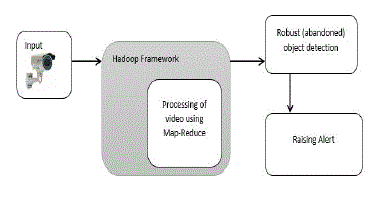 |
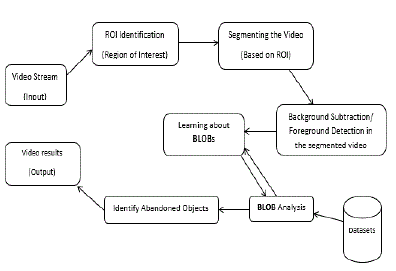 |
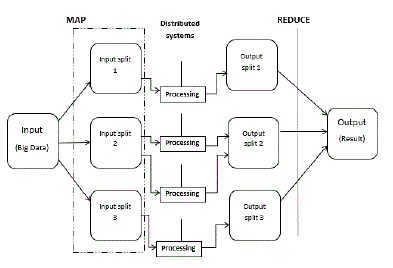 |
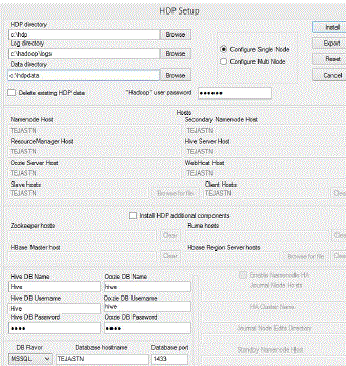 |
| Figure 1 |
Figure 2 |
Figure 3 |
Figure 4 |
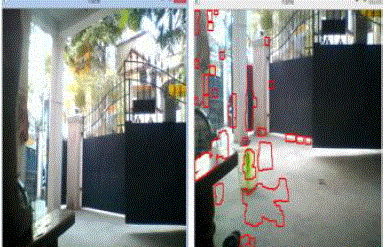 |
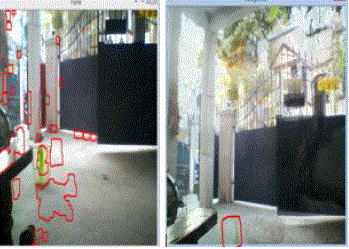 |
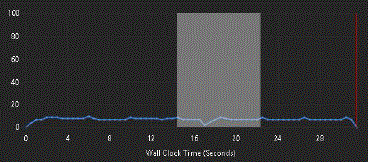 |
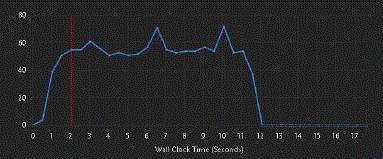 |
| Figure 5 |
Figure 6 |
Figure 7 |
Figure 8 |
|
| |
References
|
- Xu Z (2010) Smart video surveillance system.
- Singh S (2012) Big Data analytics
- Zheng Z, Zhu J, Lyu MR (2013) Service-Generated Big Data and Big Data-as-a-Service: An Overview.
- Katal A, Wazid M, Goudar RH (2013) Big data: Issues, challenges, tools and Good practices.
- Chelmsford (2013) Mass,Study: Retailers Use IP Video Surveillance for Loss Prevention Today, Business Performance Tomorrow.
- AtulBorkar, Nagmode MS, Pimplaskar D (2013) Real Time Abandoned Bag Detection Using Opencv
- Ramachandran KNN, Sajith K (2013) Abandoned or Removed Objects Detection from Surveillance Video using Codebook.
- Tian Y, Feris RS, Liu H, Hampapur A, Sun MT (2011)
- Spengler M, Schiele B (2004) Automatic Detection and Tracking of Abandoned Objects.
- Abandoned Object Recognition Using Pedestrian Detection (2013)
|